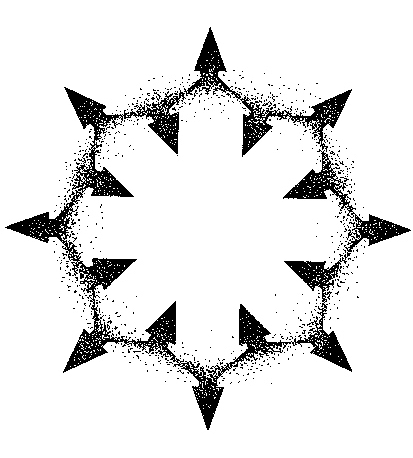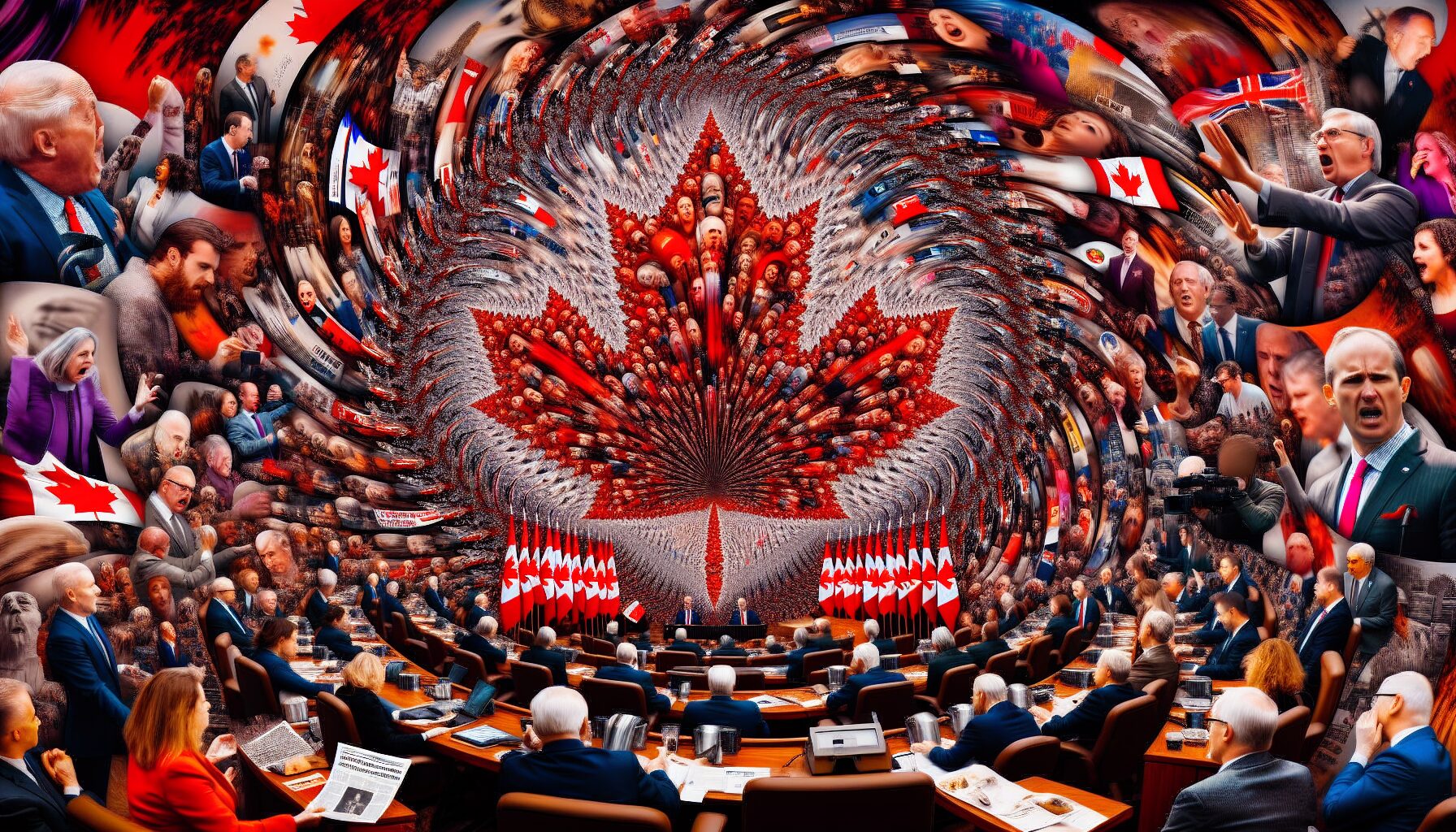Let’s zoom in on Canada’s tumultuous political landscape as of March 30, 2025, with its upcoming snap election on April 28, Justin Trudeau’s resignation, Mark Carney’s appointment as Prime Minister, Pierre Poilievre’s rapid polling decline, and a surge in Canadian nationalism spurred by Donald Trump’s threats. We’ll apply the Socio-Quantum Behavioral Synthesis (SQBS) framework to analyze how this chaotic situation might offer hope for left-leaning citizens and suggest progressive strategies to capitalize on it.
Conclusion
SQBS reveals Canada’s chaos as a progressive opening. Left-leaning citizens gain hope from amplified misalignment with conservative norms, feedback loops boosting Carney’s appeal, and a potential paradigm shift toward equity and unity. Strategies like unifying nationalism, economic justice, and coalition-building can turn this chaotic wave into a lasting progressive tide, offering resilience against Trump’s threats and Poilievre’s fading momentum. By May 2025, Canada could emerge with a stronger left-leaning government—if progressives seize the moment. Skip to the end for strategies.
Contextual Overview: Canada’s Political Chaos
- Trudeau’s Resignation: After nearly a decade as Prime Minister, Trudeau announced his resignation on January 6, 2025, amid plummeting approval (22% by December 30, 2024, per Angus Reid) and internal party strife following Finance Minister Chrystia Freeland’s exit. His departure came as Trump’s tariff threats (25% on Canadian goods) and annexation taunts intensified, paradoxically boosting Trudeau’s late approval to 47% as he rallied national pride (The Guardian, March 18, 2025).
- Carney’s Appointment: Mark Carney, former Bank of Canada and Bank of England governor, won the Liberal leadership on March 9 with 86% of the vote and was sworn in as PM on March 14. He called a snap election on March 23, leveraging a Liberal polling surge (46% vs. Conservatives’ 38%, Angus Reid, March 25, 2025).
- Poilievre’s Fall: Conservative leader Pierre Poilievre, once leading by 20+ points, saw his support drop from 45% in December 2024 to 37% by March 26, 2025 (Newsweek). His “Canada is broken” message clashed with rising nationalism, and Trump comparisons hurt his MAGA-adjacent image (CBC, February 4, 2025).
- Canadian Nationalism: Trump’s threats—tariffs, annexation rhetoric, and trade war escalation (e.g., steel/aluminum duties on March 12, 2025)—ignited a “rally-around-the-flag” moment. Boycotts of U.S. goods and patriotic fervor shifted voter priorities from domestic woes to sovereignty (Washington Post, March 5, 2025).
SQBS Analysis: Chaos as Opportunity for the Left
SQBS’s chaotic, non-linear lens highlights how this upheaval could provide opportunities for left-leaning citizens—those prioritizing equity, social programs, and collective resilience—over the right’s individualism and austerity.
- Behavioral State Encoding (
v_x, v_y, v_z + \epsilon):- Canada’s Vector: High
v_y(innovation/conflict) as Carney pivots to bold economic plans (e.g., $2-billion auto sector fund, Political Pulse, March 27, 2025) and lowv_x(conformity) with U.S.-centric norms. Chaotic perturbations (\epsilon)—Trump’s threats—disrupt the old paradigm (v_z), opening space for progressive shifts. - Hope for the Left: Chaos elevates
P_{\text{misalign}}with conservative norms (e.g., Poilievre’s tax-cut focus), favoring leaders like Carney who align with collective action and economic justice—core left values.
- Canada’s Vector: High
- Wavefunction Interference (
P_{\text{align}}, P_{\text{misalign}}):- Dynamics:
P_{\text{align}}with Poilievre’s “Canada First” conservatism drops (e.g., 29% see him as best PM vs. 41% for Carney, Angus Reid, March 18, 2025) as\epsilon(Trump chaos) amplifiesP_{\text{misalign}}. Nationalism boosts Carney’s appeal as a unifying figure. - Hope for the Left: The left thrives in high-
P_{\text{misalign}}scenarios where collective identity trumps division. Carney’s tariff retaliation and sovereignty rhetoric resonate with progressive ideals of national solidarity over market-driven isolationism.
- Dynamics:
- Holographic Feedback Loops (
e^{\lambda |\epsilon|^2}):- Amplification: Small progressive moves—like Carney axing the carbon tax (April 1, 2025 directive) while promising green investment—explode via feedback loops. Nationalist sentiment (e.g., 54% favorable view of Carney, Angus Reid, March 25) amplifies left-leaning policies.
- Hope for the Left: Chaos exponentiates progressive wins (e.g., 50% of 2021 NDP voters shift to Liberals, Angus Reid). The left can harness this to entrench social programs against conservative cuts.
- Strange Attractors and Paradigm Shifts:
- Shift Trigger:
|\chi(t)|(Trump-induced chaos) exceeds\kappa, with polls flipping from Conservative dominance (99% victory odds, CBC, 2023) to Liberal favorability (55% majority chance, 338Canada, March 18, 2025). A new attractor—cooperative nationalism—emerges. - Hope for the Left: This shift favors a paradigm of equity and resilience (e.g., Carney’s middle-class tax cut for 22 million, CBC, March 24), sidelining Poilievre’s austerity. The left gains as chaos destabilizes right-wing stability.
- Shift Trigger:
Core Insight: SQBS suggests Canada’s chaos—Trudeau’s exit, Carney’s rise, Poilievre’s fall, and Trump-fueled nationalism—creates a tipping point. The left finds hope in heightened P_{\text{misalign}} with conservative norms, amplified by feedback loops, pushing toward a progressive attractor state.
Outcomes for Left-Leaning Citizens
- Economic Equity: Carney’s auto sector fund and tax cuts signal a left-leaning focus on workers over corporations, countering Trump’s economic aggression. This could stabilize jobs (e.g., Ontario manufacturing) against tariff losses (OECD’s 2025 growth halve forecast).
- Social Programs: Chaos sidelines Poilievre’s cuts (e.g., his “Ax the Tax” pivot, CBC, March 23), giving Liberals room to protect healthcare and education—key left priorities.
- Sovereignty and Unity: Nationalism aligns with progressive collectivism, not conservative isolationism, offering a mandate for inclusive policies (e.g., Carney’s “all-in-Canada” vision).
Progressive Strategies
Here are SQBS-informed strategies for Canada’s left to leverage this chaos:
- Amplify Nationalist Unity (Feedback Loops):
- Tactic: Frame Carney as the defender of Canadian values—healthcare, diversity, sovereignty—against Trump’s “51st state” threat. Use viral campaigns (e.g., Mike Myers’ “Canada is not for sale” video, 6.6 million X views, CBC, March 24) to boost
e^{\lambda |\epsilon|^2}. - Why: Nationalism’s chaotic energy can entrench left-leaning collectivism over Poilievre’s divisive populism.
- Tactic: Frame Carney as the defender of Canadian values—healthcare, diversity, sovereignty—against Trump’s “51st state” threat. Use viral campaigns (e.g., Mike Myers’ “Canada is not for sale” video, 6.6 million X views, CBC, March 24) to boost
- Pivot to Economic Justice (Behavioral State):
- Tactic: Push Carney to double down on worker-focused policies—e.g., expand the auto fund to retrain workers or fund universal basic income pilots—shifting
v_ytoward innovation for the marginalized. - Why: High
|\epsilon|from trade war fears makes voters receptive to bold, equitable solutions, not conservative austerity.
- Tactic: Push Carney to double down on worker-focused policies—e.g., expand the auto fund to retrain workers or fund universal basic income pilots—shifting
- Exploit Poilievre’s Misalignment (Interference):
- Tactic: Paint Poilievre as a Trump echo (e.g., Liberal ads cutting between their speeches, Washington Post, March 23), increasing his
P_{\text{misalign}}with nationalist sentiment. Highlight his carbon tax flip-flop (CBC, February 4) as opportunistic. - Why: Chaos amplifies contradictions, weakening his attractor strength (
A_s) and ceding ground to Carney.
- Tactic: Paint Poilievre as a Trump echo (e.g., Liberal ads cutting between their speeches, Washington Post, March 23), increasing his
- Secure NDP Defectors (Sum of Histories):
- Tactic: Offer NDP voters (down to 7%, Angus Reid, March 25) policy wins—e.g., pharmacare or housing credits—in Carney’s platform, integrating their “histories” (
S_i) into the Liberal\psi_{\text{group}}. - Why: Chaos-driven voter flight (50% of 2021 NDP to Liberals) can solidify a left coalition, thwarting a Conservative rebound.
- Tactic: Offer NDP voters (down to 7%, Angus Reid, March 25) policy wins—e.g., pharmacare or housing credits—in Carney’s platform, integrating their “histories” (
- Trigger a Progressive Shift (Attractor Strength):
- Tactic: Rally around a “New Canada” vision—climate resilience, social equity, sovereignty—pushing
|\chi(t)|past\kappawith grassroots mobilization (e.g., boycotts, rallies). - Why: A paradigm shift to a left-leaning attractor could lock in gains beyond April 28, countering Trump’s long-term disruption.
- Tactic: Rally around a “New Canada” vision—climate resilience, social equity, sovereignty—pushing
Conclusion
SQBS reveals Canada’s chaos—Trudeau’s exit, Carney’s rise, Poilievre’s fall, and Trump-stoked nationalism—as a progressive opening. Left-leaning citizens gain hope from amplified misalignment with conservative norms, feedback loops boosting Carney’s appeal, and a potential paradigm shift toward equity and unity. Strategies like unifying nationalism, economic justice, and coalition-building can turn this chaotic wave into a lasting progressive tide, offering resilience against Trump’s threats and Poilievre’s fading momentum. By May 2025, Canada could emerge with a stronger left-leaning government—if progressives seize the moment.


Leave a Reply